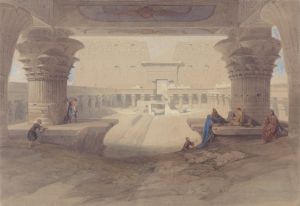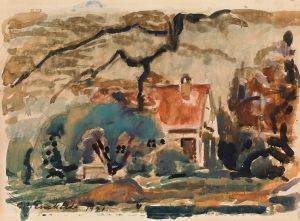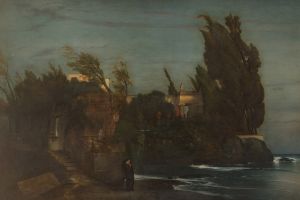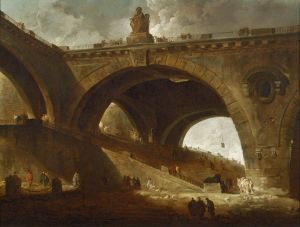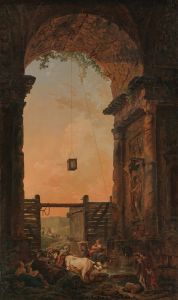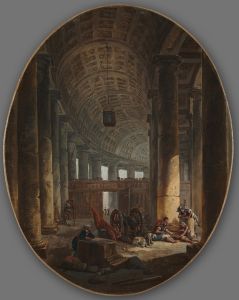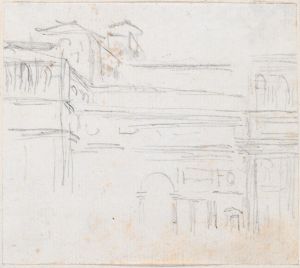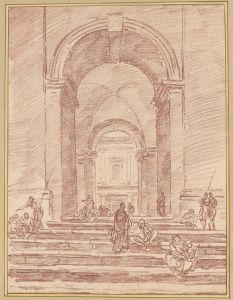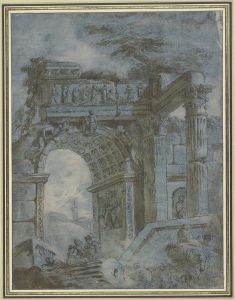
Blick durch das Atrium des Casinos in das Gartenparterre der Villa Albani
A hand-painted replica of Hubert Robert’s masterpiece Blick durch das Atrium des Casinos in das Gartenparterre der Villa Albani, meticulously crafted by professional artists to capture the true essence of the original. Each piece is created with museum-quality canvas and rare mineral pigments, carefully painted by experienced artists with delicate brushstrokes and rich, layered colors to perfectly recreate the texture of the original artwork. Unlike machine-printed reproductions, this hand-painted version brings the painting to life, infused with the artist’s emotions and skill in every stroke. Whether for personal collection or home decoration, it instantly elevates the artistic atmosphere of any space.
Hubert Robert, a prominent French painter of the 18th century, is renowned for his captivating landscapes and architectural paintings. One of his notable works is "Blick durch das Atrium des Casinos in das Gartenparterre der Villa Albani," which translates to "View through the Atrium of the Casino into the Garden Parterre of the Villa Albani." This painting exemplifies Robert's fascination with classical architecture and his ability to blend reality with imaginative elements.
The Villa Albani, located in Rome, was constructed between 1747 and 1767 for Cardinal Alessandro Albani, a notable art collector and patron. The villa was designed by the architect Carlo Marchionni and is celebrated for its extensive collection of antiquities and its beautifully landscaped gardens. It became a cultural hub for artists, intellectuals, and aristocrats during the 18th century. Hubert Robert visited Italy from 1754 to 1765, a period during which he was profoundly influenced by the classical ruins and the vibrant artistic community in Rome. His time in Italy significantly shaped his artistic style, characterized by a romanticized depiction of ruins and landscapes.
"Blick durch das Atrium des Casinos in das Gartenparterre der Villa Albani" captures the essence of the Villa Albani's architectural grandeur and its harmonious integration with nature. The painting features a view through the atrium of the casino, a small building within the villa complex, opening into the meticulously designed garden parterre. Robert's composition skillfully guides the viewer's eye from the shadowy interior of the atrium to the sunlit garden beyond, creating a sense of depth and inviting exploration.
Robert's use of light and shadow in this painting is particularly noteworthy. The contrast between the dimly lit atrium and the bright, open garden enhances the sense of space and highlights the architectural details of the villa. The garden, with its symmetrical layout and classical sculptures, reflects the influence of the Italian Renaissance on landscape design, a theme that Robert often explored in his works.
The painting also exemplifies Robert's ability to infuse his scenes with a sense of timelessness. While the architectural elements are rendered with precision, the inclusion of figures in contemporary 18th-century attire adds a layer of historical context, bridging the past with the present. This blend of antiquity and modernity is a hallmark of Robert's style, inviting viewers to reflect on the enduring legacy of classical art and architecture.
Hubert Robert's works, including this painting, were highly regarded during his lifetime, earning him a position as a member of the prestigious Académie Royale de Peinture et de Sculpture in France. His paintings continue to be celebrated for their evocative portrayal of architectural beauty and their ability to transport viewers to a world where history and imagination converge.
"Blick durch das Atrium des Casinos in das Gartenparterre der Villa Albani" remains an exemplary piece within Robert's oeuvre, showcasing his mastery of composition, light, and his deep appreciation for the classical heritage that inspired much of his work. Today, his paintings are housed in major museums and collections worldwide, where they continue to captivate audiences with their timeless charm and artistic brilliance.





